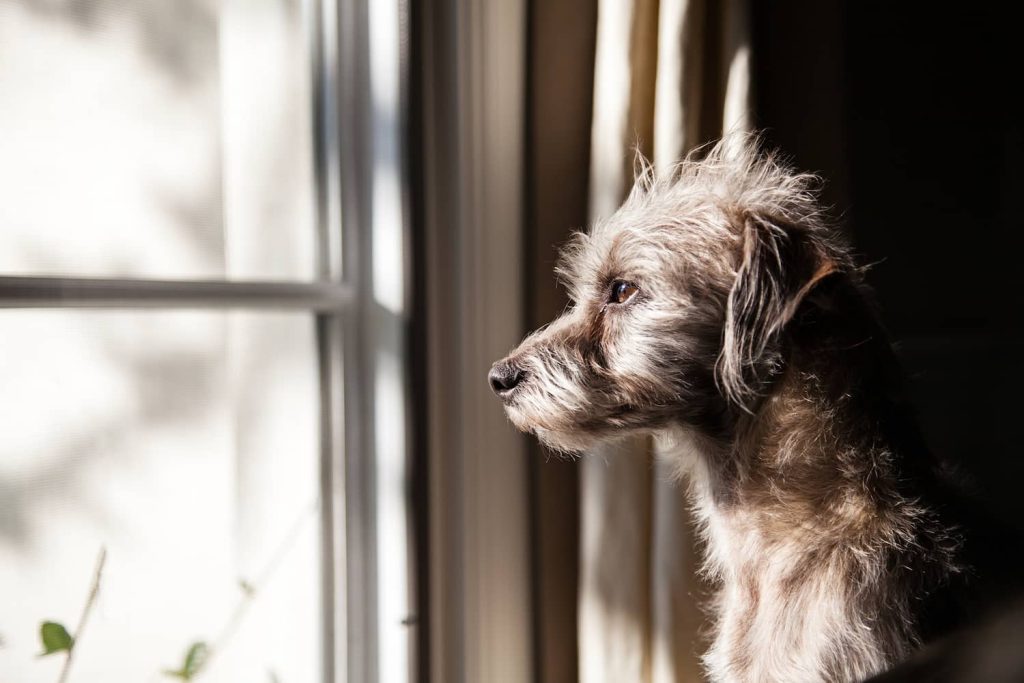Effective Techniques to Reduce Separation Anxiety in Dogs

The Impact of Separation Anxiety on Dog Behavior
Separation anxiety is a prevalent issue that affects a significant number of dogs across the United States, often leading to emotional distress and challenging behaviors. As loving pet owners, recognizing the signs of this anxiety is paramount for fostering a safe and comfortable home environment for your furry companions.
- Destructive Behavior: Many anxious dogs resort to destructive actions when left alone. Chewing on furniture, scratching at doors, and digging holes in the yard can indicate that a dog is struggling with separation anxiety. For instance, a dog that has torn up a couch or destroyed shoes may be exhibiting a cry for help, signaling their discomfort.
- Excessive Barking: Continuous barking or howling while alone is a significant indicator that a dog may be in distress. This vocalization is not just annoying for neighbors; it reflects the dog’s emotional state. It’s worth noting that some breeds, like Beagles and Dachshunds, are naturally more vocal, but if this behavior escalates, it could be attributed to anxiety.
- Pacing: Observing your dog pacing back and forth is another common sign of anxiety. This repetitive behavior can suggest that the dog is trying to self-soothe or release pent-up energy as they await their owner’s return.
Understanding the root causes of separation anxiety is crucial in addressing it effectively. Various factors can contribute to a dog’s anxiety, including:
- Change in Routine: A sudden change in a dog’s daily schedule, such as a new work shift for the owner or a recent relocation to a new home, can trigger feelings of insecurity. Dogs thrive on routine, and disruptions can lead to anxiety.
- Traumatic Events: Experiences of abandonment, whether through being surrendered to a shelter or being lost, can leave lasting emotional scars. Such traumatic events can amplify fear and anxiety when a dog is left alone.
- Lack of Early Socialization: Dogs that were not adequately exposed to new experiences or environments during their formative weeks may develop fearfulness, making them more susceptible to anxiety in unfamiliar situations.
Fortunately, there are effective techniques that can alleviate separation anxiety in dogs. Employing methods such as gradual departures helps the dog adjust to being alone without experiencing overwhelming fear. Creating a designated safe space, equipped with familiar toys and comforting items, can also provide a sanctuary for dogs during their owner’s absence. Additionally, utilizing training aids, such as anxiety-reducing collars or calming sprays, can assist in easing a dog’s distress. By incorporating these strategies, dog owners can cultivate an environment of security and comfort, transforming their pet’s experience of solitude. If you suspect your dog has separation anxiety, consider seeking guidance from a professional dog trainer or veterinarian to develop a tailored approach suitable for your furry friend.
CHECK OUT: Click here to explore more

Understanding Effective Techniques for Alleviating Separation Anxiety
For dog owners, finding effective techniques to reduce separation anxiety can significantly improve their furry companions’ quality of life. Implementing a multifaceted approach that includes behavioral training, environmental adjustments, and calming interventions can yield remarkable results. This section delves into some tried-and-true methods to help alleviate your dog’s anxiety when left alone.
Gradual Departures and Arrivals
One of the most effective strategies to reduce separation anxiety is practicing gradual departures. This technique involves conditioning your dog to understand that you will always return after leaving. To begin, start with short absences—just a few minutes at first—and gradually increase the duration as your dog becomes more comfortable. By consistently reinforcing the idea that your comings and goings are routine, you can help desensitize your pet to your absence.
Safe Space Creation
Another vital technique is creating a designated safe space for your dog. This space should be equipped with your pet’s favorite toys, bedding, and potentially an item that carries your scent, such as an old t-shirt. By creating a sanctuary where your dog feels secure, you can help them associate your absence with a comforting environment instead of feelings of anxiety. Providing access to a crate can also be beneficial, as many dogs find security in their enclosed space.
Interactive Toys and Puzzle Feeders
Engagement during your absence can be critical. Consider introducing interactive toys or puzzle feeders that require your dog to solve tasks for treats. These toys can capture your dog’s attention and keep them occupied, distracting them from your departure. The mental stimulation also promotes healthier behavioral patterns, reducing the likelihood of destructive actions stemming from boredom or anxiety.
Calming Products and Supplements
Your dog may benefit from various calming products and supplements*. Options include anxiety-reducing collars, calming sprays, and even certain supplements formulated to address canine anxiety. Always consult your veterinarian before introducing any new product to ensure it is appropriate for your pet. Utilizing these aids in conjunction with behavioral techniques can create a comprehensive approach to managing separation anxiety.
Professional Guidance
If you’ve exhausted various techniques without success, consider reaching out to a professional dog trainer or behaviorist. These experts can provide personalized guidance tailored to your dog’s unique circumstances. They can assist in developing a structured training plan and may also identify underlying issues that contribute to separation anxiety.
Incorporating these strategies into your daily routine will not only enhance your dog’s emotional wellbeing but also foster a more harmonious living environment for both you and your pet. The journey to reducing separation anxiety can be gradual, requiring patience and consistency. However, with diligent effort, numerous pet owners have successfully transformed their dogs’ experiences of being alone, paving the way for a more peaceful coexistence.
| Technique | Description |
|---|---|
| Gradual Desensitization | This method involves slowly getting your dog accustomed to being alone for short periods, gradually increasing the time. |
| Counter-Conditioning | This technique focuses on changing your dog’s emotional response to being left alone by associating it with positive experiences, like treats or favorite toys. |
| Interactive Toys | Using puzzle toys or treat-dispensing toys can keep your dog occupied and distracted while you’re away. |
| Training Commands | Teaching commands such as “stay” and “settle” can help your dog feel secure and better manage anxiety. |
Effective techniques to reduce separation anxiety in dogs can transform both your pet’s behavior and your peace of mind. Gradual desensitization offers a structured method to acclimatize your dog to being alone, progressively increasing their comfort level. Meanwhile, counter-conditioning strategically alters their emotional response to solitude by linking it with enjoyable activities. Interactive toys also play a critical role in alleviating boredom and anxiety, keeping your furry friend engaged during your absence. Incorporating training commands within training sessions instills discipline and security in your dog. These strategies collectively cultivate a more relaxed and confident pet, enhancing your bond and reducing stress for both of you. Discovering and implementing these techniques can lead to a substantial improvement in your dog’s mental well-being, allowing you both to enjoy a more harmonious life together.
CHECK OUT: Click here to explore more
Additional Strategies for Managing Separation Anxiety in Dogs
Beyond the basic techniques discussed earlier, several additional strategies can further enhance your efforts in alleviating your dog’s separation anxiety. Tailoring these tips to your dog’s unique personality and needs can lead to more effective outcomes.
Controlled Exposure to Independence
Another effective method is to promote controlled independence. This involves encouraging your dog to be comfortable spending time alone under your supervision. Start by placing your dog in a separate room for brief periods while you remain within earshot. Gradually increase the time your dog stays in isolation, allowing them to understand that solitude can be a positive experience. This gradual process enables your dog to build confidence and reduces the fear associated with being left alone.
Training with Leave-It and Stay Commands
Training your dog in fundamental commands like leave-it and stay can provide a framework for managing their behavior when you are about to leave. By gently reinforcing these commands, you can cultivate a sense of discipline and control over your dog’s reactions. For instance, when you prepare to leave the house, instruct your dog to stay in a designated area, rewarding them with treats for compliance. This training can foster a sense of security, as they will learn that their obedience leads to positive reinforcement, even during your absences.
Counter Conditioning Techniques
Counter conditioning is a powerful tool in the fight against separation anxiety. This technique involves changing your dog’s emotional response to being left alone by associating it with positive experiences. For example, when you start your leaving routine—such as picking up your keys or putting on your shoes—offer high-value treats to your dog. Over time, they begin to associate your departures with something enjoyable rather than anxiety-inducing. The goal here is to gradually desensitize your dog until your absences become less distressing.
Utilizing Technology
In our increasingly tech-savvy world, using technology can be a game-changer for managing separation anxiety. Devices like interactive cameras allow you to monitor your dog’s behavior when you’re not home, while also offering two-way communication—enabling you to soothe and reassure them remotely. Additionally, there are smart toys that dispense treats or engage your pet in activities, which can keep them occupied during your absence.
Regular Exercise and Mental Stimulation
Ensuring your dog receives adequate exercise and mental stimulation is crucial in alleviating anxiety. Take them for daily walks, play fetch in the yard, or engage in training sessions to keep their minds active. This prolonged engagement can tire them out physically and mentally, making them less prone to anxious behaviors when left alone. Regular exercise minimizes pent-up energy and promotes a calmer disposition overall.
Consider Dog Daycare or Playdates
If feasible, consider enrolling your dog in dog daycare or arranging regular playdates with other dogs. This social interaction can provide your pet an outlet for their energy and reduce anxiety by promoting positive associations with being around people and other dogs. Interacting with playmates in a supervised setting offers engagement and can decrease feelings of isolation when you’re not around.
Combining these strategies effectively will create a comprehensive plan tailored to your dog’s needs. Addressing separation anxiety requires dedication and empathy, as many dogs suffer significantly from this condition. By utilizing a variety of approaches and continuously monitoring their progress, owners can make significant strides toward minimizing their dogs’ distress when separated.
SEE ALSO: Click here to read another article
Conclusion: A Comprehensive Approach to Combat Separation Anxiety in Dogs
Addressing separation anxiety in dogs is not just a matter of implementing a few techniques; it requires a holistic approach that combines patience, understanding, and effective strategies tailored to each dog’s unique temperament. Through a blend of training, socialization, and technology, pet owners can empower their dogs to manage their anxiety more effectively.
Starting with gradual techniques like controlled independence and reinforcing commands such as leave-it and stay lays a strong foundation for your dog’s behavioral confidence. Coupling these with counter conditioning helps reshape their emotional responses to your departures, ultimately leading to less distress during separations. Additionally, leveraging technology can enhance your ability to monitor and interact with your dog, offering peace of mind while improving your dog’s comfort level in your absence.
Moreover, engaging your dog in regular physical activity and mental stimulation will minimize anxiety triggers by keeping them well-exercised and mentally engaged. Utilizing options like dog daycare or scheduled playdates can further aid in building their social skills, thereby reducing feelings of isolation.
By comprehensively addressing separation anxiety through varied techniques and high-quality care, you can significantly elevate your dog’s quality of life. Remember, your journey towards a calmer, more secure dog is a marathon, not a sprint. With continuous effort and a commitment to understanding your dog’s needs, you can transform their anxiety into confidence, allowing both of you to enjoy your time apart and together.



